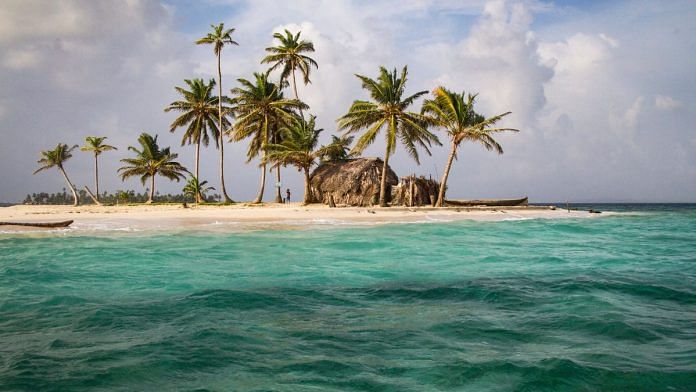New Delhi: The inhabitants of a small Carribean island, faced with the loss of their home as a result of the climate crisis, are about to become some of the Americas’ first climate refugees. But far from being helpless, the islanders — members of the indigenous Guna community — have ensured that there will be a new, sustainable home waiting for them on the mainland of their country, Panama.
The island of Cartí Sugtupu or Gardi Sugdub, in the San Blas archipelago, comes under Panama’s Guna Yala province. Located 1,200 metres off the northern coast of mainland Panama, it is the biggest and southernmost of the four inhabited Carti Islands. The Guna people have lived on this and other islands in the region for more than a century.
The sea at Gardi Sugdub is now rising at 3.4mm per year, more than double the rate seen in the 1960s. It is almost certain that all of the 49 islands inhabited by the Guna will have to be abandoned by 2100, as most are now barely half a metre to one metre above the water, according to climate experts.
According to a BBC report, Gardi Sugdub’s roughly 1,3000 inhabitants are due to relocate to a new village, Isber Yala, in February this year, due to the raised sea levels and other factors endangering the island’s survival.
Confronted with a climate crisis, the islanders planned their own relocation. The move will come after 14 years of effort. Since 2010, the community has reluctantly embraced the only viable, sustainable option — relocating to a safer mainland site.
After years of advocacy by the community and NGOs, the Panamanian Ministry of Housing pledged in 2017 to construct 300 new homes at a community-owned mainland location, according to a report by Human Rights Watch (HRW), an international non-governmental organisation, in 2023
After eight years, the houses are nearly done, and the sea, which was once the livelihood of the fishing community, has forced its inhabitants to retreat to the mainland — the one that they had to flee after the Spanish colonisation in the 15th century, said the BBC report.
Also Read: 200 countries adopt ‘historic’ COP28 deal calling for transition away from fossil fuels for 1st time
Impact of climate change
The rising sea levels aren’t the only reason Gardi Sugdub is fast becoming uninhabitable.
According to the HRW report, the island’s original size was approximately half of what it is now. However, over time, the inhabitants gradually expanded the landmass by using the surrounding coral reefs, garbage, rocks, and concrete blocks.
Although this ‘filling’ method has made the island larger, it has also made it more prone to erosion and flooding by removing the coral reefs that had previously protected it from storms, the report added.
Life has also grown more difficult for the islanders. The Guna people of the San Blas archipelago have had a long tradition of subsistence fishing; sometimes, they have supplied seafood to some of Panama City’s finest eateries, the HRW report said.
However, fishing has become harder in the past few years with higher sea levels, overcrowding on Gardi Sugdub, and the worsening of coral reef degradation in the area. This has made many islanders rely on tourists, according to the BBC report.
Planned relocation
HRW’s report discussed the need to ensure a better quality of life for both the relocating people and the host communities.
In the island’s case, some changes have been made. Instead of huts with thatched roofs located by the sea, the new town, Isber Yala, now has concrete houses that are several miles away from the water, said the BBC report.
While there is still work to be done, including creating a water sanitation system, the 300 houses on Isber Yala are expected to be ready in February after years of delay. They could give the islanders “the one thing they lack: a secure future”, the BBC report said.
(Edited by Richa Mishra)
Also Read: Lethal floods in Libya, wildfires in Europe, ‘heat dome’ in US — 10 climate disasters in 2023



